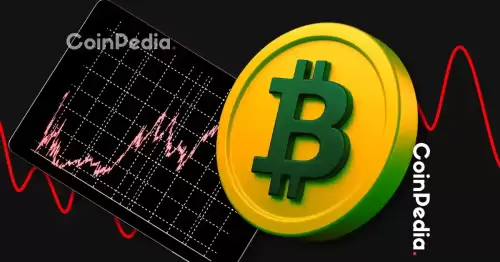 |
|
 |
|
 |
|
 |
|
 |
|
 |
|
 |
|
 |
|
 |
|
 |
|
 |
|
 |
|
 |
|
 |
|
 |
|
Cryptocurrency News Articles
Polkadot Crypto: Trends, Analysis, and Future Outlook 2025
May 18, 2025 at 11:41 am
This article will cover the Polkadot network, its architecture, tokenomics, ecosystem growth, and future outlook.

Polkadot (DOT) is a next-generation blockchain platform designed to enable interoperability among multiple blockchains, known as “parachains,” within a unified ecosystem. Launched in 2020 by Gavin Wood, a co-founder of Ethereum, Polkadot aims to address fundamental limitations of legacy blockchains, such as scalability, governance, and cross-chain communication.
Its native cryptocurrency, DOT, serves multiple purposes: facilitating network governance, bonding for parachain slots, and staking for network security.
As the blockchain industry matures into 2025, Polkadot is positioned as a crucial infrastructure protocol in the push toward a truly decentralized web, or Web3.
Introduction to Polkadot
Polkadot is a protocol that connects different blockchains together, aiming to improve communication and data transfer between them. It's designed to handle more transactions per second than Bitcoin and has a more flexible governance system than Ethereum.
The project is supported by the Web3 Foundation, and its token (DOT) is used for governance and parachain bidding. Parachains are specialized blockchains that connect to the Relay Chain for shared security and interoperability.
Its architecture features a Relay Chain, which provides network security and consensus, and parachains, which serve specific use cases and connect to the Relay Chain for shared security.
Parachain slots are limited, and projects bid DOT tokens to secure them, creating a market-driven approach to allocating resources.
Polkadot’s Architecture and Technology
Polkadot is a multichain protocol designed for interoperability, scalability, and security in decentralized applications. It operates as a relay chain, providing network consensus and security, and supports numerous parallel blockchains called parachains. These parachains can communicate and share information seamlessly, addressing key limitations found in many legacy networks.
The technology has matured significantly, with over 50 active parachains on the network by early 2025. These parachains span a variety of use cases, including DeFi, NFTs, gaming, and privacy solutions, reflecting the ecosystem’s expansive growth. The relay chain uses a nominated proof-of-stake (NPoS) consensus mechanism, which relies on validators and nominators to maintain network security while offering robust incentives for honest behavior. This model has demonstrated strong resilience against attacks and has kept the network highly decentralized and secure.
A defining feature of Polkadot’s architecture is its cross-chain messaging protocol, known as XCMP (Cross-Chain Message Passing). XCMP allows parachains to exchange data and assets efficiently without relying on centralized intermediaries, paving the way for a truly interoperable blockchain ecosystem. The ongoing development of XCMP v2, expected to further reduce latency and costs, is a critical milestone for the network in 2025.
Polkadot’s on-chain governance continues to evolve. The recent launch of OpenGov, a decentralized governance mechanism, empowers DOT token holders to propose and vote on network upgrades and policy changes directly. This fosters a more democratic and agile approach to protocol evolution, with several core upgrades—including asynchronous backing and parachain scaling—already implemented through community consensus.
Looking ahead, Polkadot’s roadmap emphasizes enhanced scalability and cross-ecosystem compatibility. The introduction of asynchronous backing is expected to increase parachain block production rates by up to 10x, further driving network throughput and supporting mainstream adoption. Additionally, bridges connecting Polkadot to other networks like Ethereum and Cosmos are being actively developed, aiming to cement Polkadot’s role as the backbone of a multi-chain Web3 future.
Tokenomics and DOT Utility
Polkadot’s native token, DOT, is at the core of the network’s tokenomics and utility model. DOT continues to serve several critical functions within the Polkadot ecosystem, including network governance, staking, and the facilitation of parachain slot auctions. Since its 2020 mainnet launch, Polkadot has advanced its economic model to incentivize decentralized governance and robust network security, ensuring the sustainability and growth of its multichain architecture.
Looking ahead to the remainder of 2025 and beyond, Polkadot’s tokenomics are expected to evolve further. Ongoing governance upgrades, enhanced cross-chain functionality, and continued parachain development are likely to increase demand for DOT. Analysts project that these dynamics—combined with a capped annual inflation rate of approximately 10%—will support DOT’s utility and value proposition as the multichain ecosystem matures.
Ecosystem Growth and Parachains
Polkadot’s ecosystem growth and the evolution of its parachain model are central to its 2025 outlook. By early 2025, Polkadot has established itself as a leading multichain platform, with over 50 parachains live on the network, each serving specialized use-cases such as DeFi, NFTs, gaming, and decentralized identity. The parachain slot auction mechanism
Disclaimer:info@kdj.com
The information provided is not trading advice. kdj.com does not assume any responsibility for any investments made based on the information provided in this article. Cryptocurrencies are highly volatile and it is highly recommended that you invest with caution after thorough research!
If you believe that the content used on this website infringes your copyright, please contact us immediately (info@kdj.com) and we will delete it promptly.






























































